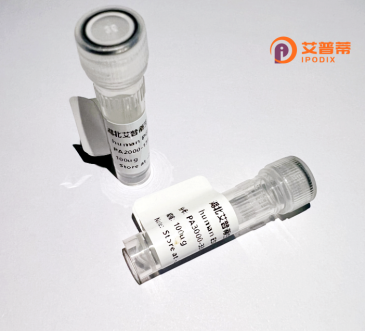
| 纯度 | >90%SDS-PAGE. |
| 种属 | Human |
| 靶点 | RAD51C |
| Uniprot No | O43502 |
| 内毒素 | < 0.01EU/μg |
| 表达宿主 | E.coli |
| 表达区间 | 1-376 aa |
| 活性数据 | MRGKTFRFEM QRDLVSFPLS PAVRVKLVSA GFQTAEELLE VKPSELSKEV GISKAEALET LQIIRRECLT NKPRYAGTSE SHKKCTALEL LEQEHTQGFI ITFCSALDDI LGGGVPLMKT TEICGAPGVG KTQLCMQLAV DVQIPECFGG VAGEAVFIDT EGSFMVDRVV DLATACIQHL QLIAEKHKGE EHRKALEDFT LDNILSHIYY FRCRDYTELL AQVYLLPDFL SEHSKVRLVI VDGIAFPFRH DLDDLSLRTR LLNGLAQQMI SLANNHRLAV ILTNQMTTKI DRNQALLVPA LGESWGHAAT IRLIFHWDRK QRLATLYKSP SQKECTVLFQ IKPQGFRDTV VTSACSLQTE GSLSTRKRSR DPEEEL |
| 分子量 | 42.1 kDa |
| 蛋白标签 | His tag N-Terminus |
| 缓冲液 | PBS, pH7.4, containing 0.01% SKL, 1mM DTT, 5% Trehalose and Proclin300. |
| 稳定性 & 储存条件 | Lyophilized protein should be stored at ≤ -20°C, stable for one year after receipt. Reconstituted protein solution can be stored at 2-8°C for 2-7 days. Aliquots of reconstituted samples are stable at ≤ -20°C for 3 months. |
| 复溶 | Always centrifuge tubes before opening.Do not mix by vortex or pipetting. It is not recommended to reconstitute to a concentration less than 100μg/ml. Dissolve the lyophilized protein in distilled water. Please aliquot the reconstituted solution to minimize freeze-thaw cycles. |
以下是关于重组人RAD51C蛋白的3篇代表性文献:
1. **文献名称**:*Germline mutations in RAD51C cause hereditary breast and ovarian cancer*
**作者**:Vaz, F. et al. (2010)
**摘要**:该研究首次发现RAD51C的生殖细胞失活突变与遗传性乳腺癌和卵巢癌风险显著相关,提示其作为肿瘤抑制基因在DNA修复中的作用。
2. **文献名称**:*RAD51C-XXRCC2 structure and cancer-associated mutations define mechanisms for RAD51C recruitment and repair center regulation*
**作者**:Hustedt, N. et al. (2019)
**摘要**:通过解析RAD51C与XRCC2形成的复合物结构,阐明了RAD51C在招募至DNA损伤位点的分子机制,并揭示癌症相关突变对其功能的影响。
3. **文献名称**:*RAD51C deficiency is synthetically lethal with BRCA2 via PARP inhibition*
**作者**:Somyajit, K. et al. (2017)
**摘要**:研究发现RAD51C缺失的细胞对PARP抑制剂敏感,其机制类似于BRCA2突变,表明靶向HR缺陷(如同源重组修复缺陷)的潜在治疗策略。
以上文献分别从疾病关联、结构机制和靶向治疗角度揭示了RAD51C在DNA修复及癌症中的作用。
RAD51C is a crucial member of the RAD51 protein family, which plays a central role in homologous recombination (HR), a high-fidelity pathway for repairing DNA double-strand breaks (DSBs) and maintaining genomic stability. As an ATP-dependent recombinase paralog, RAD51C is distinct from the core recombinase RAD51 but works cooperatively with other RAD51 paralogs (RAD51B, RAD51D, XRCC2. XRCC3) to form functionally distinct protein complexes. These complexes facilitate critical steps in HR, including RAD51 nucleoprotein filament formation, homology search, and strand exchange. RAD51C specifically associates with XRCC3 to stabilize replication forks and promote crossover resolution during meiosis.
Mutations in RAD51C are linked to hereditary cancers, particularly breast and ovarian cancers, and are associated with Fanconi anemia-like disorders, underscoring its role in genome integrity. Biallelic pathogenic variants disrupt HR efficiency, leading to chromosomal instability and heightened cancer susceptibility. RAD51C-deficient cells exhibit hypersensitivity to DNA crosslinking agents (e.g., cisplatin), reflecting impaired DSB repair. Beyond repair, RAD51C contributes to telomere maintenance and replication stress responses. Its interaction with BRCA1/2 and participation in Fanconi anemia pathway crosstalk highlight its centrality in DNA damage response networks.
Research continues to explore RAD51C as a potential therapeutic target and biomarker for cancers with defective HR, particularly in tailoring PARP inhibitor treatments.
×